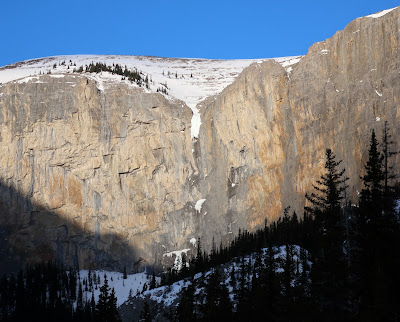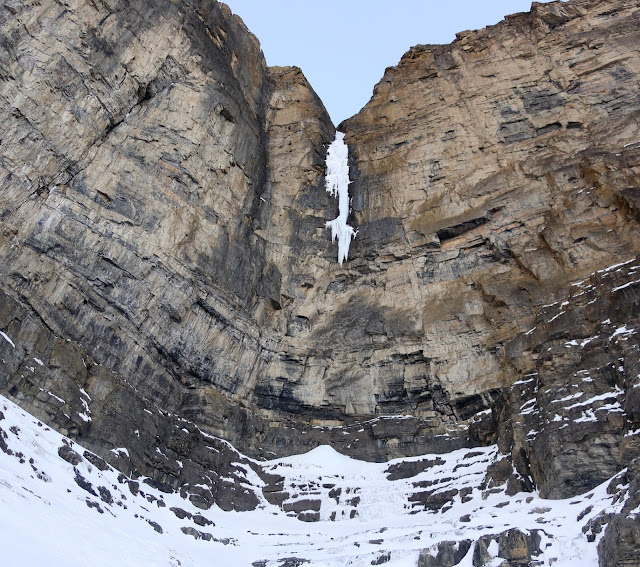Little Fluffy Clouds
Take 1.
From a distance, the ice blobs looked inviting; the featureless rock between them, less so. I wonder if we're wasting our time, I thought, as Seth and I ploughed a ski track through facetted snow, the straps of packs loaded down with ropes, cams, pins – and drill – pulling at our shoulders. Given enough time and bolts you can get up anything, but we didn't want what Steve DeMaio called a science project. We wanted a line, something we could walk up to and (mostly) just climb. Unfortunately, the limestone, shining grey and yellow in the morning light, looked depressingly blank. But another one of Steve’s sayings was that you’ve just got to rub your nose in it. And sure enough, as we got closer, switchbacking up the slope below the cliff through patches of kinnikinnick and drifts of wind-crusted snow, as if by magic cracks and corners appeared.
Seth quickly dispatched the first pitch, a curtain of sun-baked ice, and I started up the second. A horizontal shuffle across a van-sized flake, another ice blob, and I started up steeper rock aiming for a big left-facing corner. After a few moves, with no gear between me and the ice ledge below, I looked around for a piton crack. That one’s just a blind seam, that one’s behind a loose flake, but this one looks promising. I slotted in a knifeblade and gingerly started hammering. Ping! Following a graceful parabolic arc, the pin disappeared from view. I vainly tried a few more cracks but, in the end, gave in and pulled up the drill. Several bolts and some pick torqueing in a corner crack later, I pulled over the overhanging lip of the next ice blob onto a comfortable ledge.
We climbed one more pitch to reach another ice blob before the drill battery and daylight started to fade. Happy that the day hadn’t turned out to be a waste of time after all, we headed down. First though, we sorted the gear, and left the ropes and rack hanging from an ice tool hooked over a rock edge. With light packs, we skied back to the car while the stars came out over the frozen bog, and Venus and the crescent moon set over Devil’s Head.
A line or a science project? Little Fluffy Clouds from the valley bottom.
Seth Keena nears the end of the first pitch, with ice clouds big and small floating overhead.
Yours truly sorts out the left-facing corner on the second pitch. Photo: Seth Keena.
The backside of Blackrock Mountain, with the office towers of Calgary in the distance.
As the sun swings around the corner, I squeeze one last pitch (the third) out of the day. Photo: Seth Keena.
A waxing crescent moon and Venus setting over Devil's Head.
Take 2.
The packs were lighter when we came back a few days later. Following our old track along a cutline, through a short stretch of bush and onto an open streambed, we made good time and arrived at the base of the rock together with the sun. But our satisfaction was short lived. As we took down the stashed gear, we saw sharp tooth marks on the handles of my ice tools. Worse, our rope was chewed right through. A wave of disappointment washed over me: our climbing day was over before it’d begun. But wait! As we uncoiled the rope, we saw the rats had merely wanted to scare us, and had only bitten off a two-metre section. We could go climbing after all.
It didn’t take us long to reclimb the first three pitches, and we were still in the sun as I started up the fourth. Unfortunately, it looked to be the science project we’d been hoping to avoid. Wherever I dared, I tried to climb between bolt placements to avoid putting up an aid ladder, but didn’t manage to place even a token piece of gear. A couple of hours later, having touched the final ice curtain but still somewhat disheartened, I lowered back to the now shady belay. My spirits did rise a bit as I belayed Seth on the freshly bolted pitch, and saw that at least it appeared to be climbable. As the song goes,
You can't always get what you want
But if you try sometime you find
You get what you need.
Nooo! Photo: Seth Keena.
As we eye pitch four, it looks suspiciously like a science project. Photo: Seth Keena.
Take 3.
Two days later we were back, with Maia rounding out the team. On our previous goes we’d enjoyed temperatures that were unseasonably warm for January, belaying barehanded and climbing in base layers. Now, however, February had arrived with cold, wind and snow. White devils danced across the gravel flats on the valley bottom, and a cold wind drove plumes of powder from surrounding ridges. At least the base of the cliff was somewhat sheltered from the gusts.
The sun-baked ice on pitch one, the now much less chossy corner on pitch two, and the groove connecting two ice blobs on pitch three. Pitch four was the big unknown. Just a few metres from the belay I was already struggling to keep my fingers warm, as I repeatedly locked off and searched for a good edge. It was tempting to commit to one of the bad ones and go for it, but I also knew this kind of scratching demanded patience. Maia and Seth, bundled up at the belay, were probably less impressed with my slow, methodical progress.
Then it was my turn to try to stay warm, as clouds of spindrift enveloped me while I brought my partners up. If one of them had said that conditions were too miserable to climb the last pitch, that we should just head down, I wouldn’t have argued. But they didn’t. A few more long reaches; balancing across a foot ledge with the blank wall above trying to push me off; and cold, brittle ice that cracked and groaned as I repeatedly swung into it. I tried to keep my eyelids from freezing shut while I drilled a v-thread where the ice backed off into snow-covered scree. Now just a few rappels remained before we could run down to our skis and get warm again.
Maia Schumacher skis along the frozen bog, with the Hydrophobia cirque straight ahead and the Johnson Creek drainage on the right.
The wind drives plumes of fresh powder from the clifftop.
Yours truly heads up the second pitch for the third time... Photo: Seth Keena.
... while Maia Schumacher enjoys it (?) for the first time. Photo: Seth Keena.
Seth Keena starts up the grove on pitch three...
... and yours truly tries to sort out the cryptic sequences on the fourth. Photo: Maia Schumacher.
Snagging the ice on the fifth and last pitch. Photo: Maia Schumacher.
Little Fluffy Clouds, 155 m, M7 WI4
FA: Seth Keena, Maia Schumacher and Raphael Slawinski, January-February 2020
This spectacular route is found at the mouth of the Johnson Creek drainage, before Caroline and Marion Falls. If formed, the ice blobs and final curtain will be obvious on the sunny side of the valley.
Approach: Park as for all Waiparous routes, on the north side of Waiparous Creek. Approach as for Hydrophobia to the bog, then veer right onto a cutline. From where the cutline ends, 10 minutes of bushwhacking deposits you on the cobbles of Johnson Creek. Walk up the creek until below the route, then hike up through open forest and scree to the base. In heavy snow years skis may be useful. 1.5-2 hours.
Route:
Pitch 1 (30 m, WI3+). Steepening ice leads to a ledge. Traverse right to a single-bolt belay that can be backed up with a #5 Camalot behind the flake on the right.
Pitch 2 (40 m, M5+). Traverse right across the flake to an ice blob. From the right edge of the ice blob, climb rock past 3 bolts to a left-facing corner. Climb the corner past another bolt to the left edge of a bigger ice blob and a 2-bolt belay on top of the blob. Small cams and nuts needed on this pitch but not higher, and this gear can be left at the belay. Long slings are helpful.
Pitch 3 (20 m, M4+). Move right from the belay and climb past 4 bolts to an easy wide crack that leads to a 2-bolt belay on top of a small ice blob. #3 and 4 Camalots are useful on this pitch.
Pitch 4 (30 m, M7). Tricky drytooling leads to easier but more committing climbing. Another tricky section leads to a 2-bolt anchor on a small ledge. This pitch is all bolted but a #3 Camalot may be comforting.
Pitch 5 (35 m, M5 WI4). Some long reaches lead to the right end of a foot ledge. Shuffle left along the ledge to the hanging curtain. Snag the ice and climb it to where it backs off into snow. Belay from ice. This pitch is all bolted and only requires screws.
Descent: Rappel the route from the top of pitches 5, 4 and 2. Pitches 5, 4 and 3 can be rappelled with a single 70-m rope. Rappelling from the top of pitch 5 requires back clipping some of the bolts on the pitch. Rappelling straight down from the top of pitch 2 requires two 70-m ropes. With 60-m ropes, rappel to the top of pitch 1 and make another rappel from the single bolt there.
Gear: 70-m ropes, doubles of Camalots from #0.2 to 0.4 (or a single set of cams and a few medium Stoppers), Camalots #3, 4 and 5 (optional), 8 quickdraws, 6 extendable draws, 5-6 screws.
Note: For convenience, rap stations are set up with quick links and biners instead of rap rings. Unless you really need to add to your collection of crappy old biners, please leave the biners in place.



















As a travel enthusiast, I'm always on the lookout for practical tips and recommendations, and this blog never disappoints. The detailed itineraries, budget-friendly suggestions, and insider advice are a goldmine for anyone planning their next trip. I appreciate the effort put into making travel accessible for all.
ReplyDelete